Honda, despite an apparent design ethos that ignores traditional customers while tempting those who might have never seen an actual motorcycle in the flesh, isn’t so blind that it can’t recognize a gap in the product line. That’s a very old-school awareness, dating back to the days when the step from a 250 to a 500 was deemed great enough to warrant a 350 and a 400 in between. Just in case, yeah?
So it is today: Between the sporty starter-sauce twin called the CBR500R and the hard-core (if slightly aged) CBR600RR, there remains enough space to drive another motorcycle through.
This one, in fact.
Welcome the 2014 Honda CBR650F, a fully faired sporty bike meant to be a step up from the parallel-twin CB500 series. Like its smaller brother, this one also hails from the land of Pad Thai to help costs down. You can see elements of the 650 in most of Honda’s latest sporting gear—construction in Thailand, sure, but also a style of wheel and brake designed to be lighter by having fewer parts, reliance on good-old steel for chassis structure, and simple plastics.
And while you might assume the engine is some regurgitated CBR600F4i engine or maybe a lump out of a domestic-market bike we’ve never seen, the truth is that it’s an all-new design. It shares the current CBR600RR’s 67mm bore—which makes you think this engine can be built on the same tooling—but packs a 46mm stroke, up from 42.5mm in the RR, to micrometer-out at 649cc. It is otherwise a totally conventional, across-the-frame four banger, with dual overhead cams, four valves per cylinder, stacked transmission for compactness, and fuel injection.
You can tell by the specification what Honda had in mind here: a wide band of power with emphasis on midrange torque. The injection is a simple, non-fly-by-wire setup with 32mm throttle bores, 8mm smaller than the CBR600RR’s. Compression ratio is a modest 11.4:1 (from the RR’s 12.2:1) and the cam timing and lift must be aimed at making the “strong low-end torque below 6,000 rpm” that Honda claims. All the company will say about the cams is they have “minimal valve overlap.” The engine has visibly long, thin exhaust ports.
All of these characteristics point to an engine built for torque, not eye-widening high-rpm horsepower figures. Proof? According to Honda’s reps, in the 650’s mandate “horsepower is not the big deal,” going on to say that this liquid-cooled engine makes 86 hp at the crank, which we’ll predict ends up as 73 at the rear wheel. We’ll conclude the barstool estimating by calling this about 10 hp better than Kawasaki’s Ninja 650 or Yamaha’s FZ6R.
On the road, the Honda does nothing to disabuse those from-the-hip predictions. The engine is smooth and strong just above idle, and along with a very smooth and light clutch action (from a cable, not hydraulics) makes it gratifyingly easy to get under way. Honda knows that the CBR-F could be the first sportbike for many riders, and everything about it needs to be “easy” and “rewarding” and “unintimidating.”
Just as Honda says, the 650 packs good torque below 6,000 rpm, enough to slither through suburbia well ahead of Priuses and Volts. For best results on a mountain road, keep the sizzling little four between 6,000 and about 9,500 rpm. That last 2,000 rpm to the 11,500-rpm redline offers some over-rev range but not a lot more useful thrust. Plus, the engine gets progressively buzzier as it nears redline.
In every way, the CBR650F’s chassis mirrors what the engine is designed to do. What looks like an aluminum-spar frame from 10 feet is actually oval-section steel tube. Clever, Honda; very clever. With a 57-inch wheelbase and moderate steering geometry (25.3 degrees of rake and 3.98 inches of trail), the not-super-light, 461-pound (claimed) CBR has reflexes a tick or three slower than a full-strength supersport. The intention here is, again, to build a confidence-inspiring ride that never even hints that it could turn around and bite the rider.
That Honda has done. Swerving up and down some of Malibu, California’s best mountain roads, the CBR acquitted itself well, providing crisp turn-in, stability in the middle of corners, a willingness to change lines if necessary, and a general sense that as long as you keep the peg feelers off the tarmac, all will be fine. Nothing happens too quickly, but the bike isn’t dead feeling, either; it’s precisely the right balance for the intended buyer. Honda absolutely nailed the approach, where nothing stands out. The engine power delivery and character, brake performance (sufficiently strong but with a gentle ramp-up), and suspension calibration (softly sprung but never harsh and rarely too mushy) all line up beautifully.
If you’ve come over from the side of the tracks where performance isn’t the main focus, the CBR-F will seem like a happy puppy of a motorcycle, able to string together corners in an exhilarating way. But it also has a measure of performance lacking in the CB500F or CBR500R, to the tune of about 20 hp, and that makes a huge difference. Plus, you get a nicely muted wail from the 650.
Where the CBR650F lines up against its entry-level sportbike brethren will make an interesting comparison. First impressions are that the Honda is smoother and more refined than the general level of the class, which it’ll have to be to justify the $8,499 price tag. (It’s $8,999 with very good ABS, though you’ll have to settle for the so-yesterday matte-black paint to get ABS, otherwise you can choose from a nice Honda red or a handsome, not-quite-Yamaha blue on the non-ABS models.) Remember that the Kawasaki Ninja 650 costs $7,699, Suzuki’s Gladius...er, SFV650, is $8,149, and Yamaha’s FZ6R runs $7,790. Plus you have the new wildcard, the Yamaha FZ-07, at a mere $6,990. We’ll get these bikes together soon for a definitive answer, but the Honda promises to be an extremely strong competitor in an important category. The CBR650F might be a gap-filler for Honda, but it’s definitely not a sportbike placeholder.
VERDICT 4.5 stars
Honda aims for and squarely hits the step-up sportbike bull’s eye. Smooth, easy to ride, yet still fun.










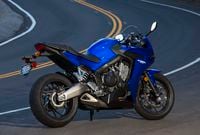

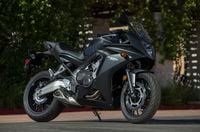

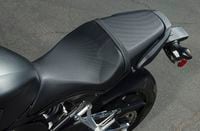


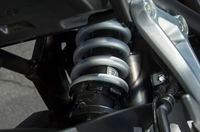
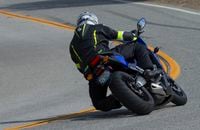
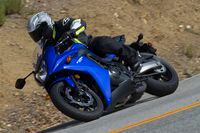


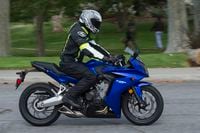
/cloudfront-us-east-1.images.arcpublishing.com/octane/TNOU5DNE2BC57MFPMGN2EIDXAM.jpg)
/cloudfront-us-east-1.images.arcpublishing.com/octane/GTCXACQGJ5HAPDTGWUQKDEH44E.jpg)
/cloudfront-us-east-1.images.arcpublishing.com/octane/S35YGSEMEZB4BLTDJTSZPF4GLA.jpg)
/cloudfront-us-east-1.images.arcpublishing.com/octane/5UOT6HPX2JFMRJAX6EH45AR4MQ.jpg)
/cloudfront-us-east-1.images.arcpublishing.com/octane/OKWOJWAKP5EP3OACCRRWPCIX2Q.jpg)
/cloudfront-us-east-1.images.arcpublishing.com/octane/2WF3SCE3NFBQXLDNJM7KMXA45E.jpg)
/cloudfront-us-east-1.images.arcpublishing.com/octane/G4MG6OUCJNBSHIS2MVVOTPX65E.jpg)
/cloudfront-us-east-1.images.arcpublishing.com/octane/IIGGWFOTOJGB7DB6DGBXCCMTDY.jpg)
/cloudfront-us-east-1.images.arcpublishing.com/octane/QSTCM6AVEZA5JJBUXNIQ3DSOF4.jpg)
/cloudfront-us-east-1.images.arcpublishing.com/octane/U4I7G625B5DMLF2DVIJDFZVV6M.jpg)
/cloudfront-us-east-1.images.arcpublishing.com/octane/B6XD6LS6IVCQPIU6HXDJSM3FHY.jpg)
/cloudfront-us-east-1.images.arcpublishing.com/octane/ICL63FEDDRDTTMINYICCEYGMDA.jpg)
/cloudfront-us-east-1.images.arcpublishing.com/octane/FCGZHQXRBZFLBAPC5SDIQLVF4I.jpg)
/cloudfront-us-east-1.images.arcpublishing.com/octane/WNOB6LDOIFFHJKPSVIWDYUGOPM.jpg)

/cloudfront-us-east-1.images.arcpublishing.com/octane/X33NU3E525ECRHXLNUJN2FTRKI.jpg)
/cloudfront-us-east-1.images.arcpublishing.com/octane/6KKT5NNL2JAVBOXMZYS5ZO76YA.jpg)
/cloudfront-us-east-1.images.arcpublishing.com/octane/J5RKG5O455GMPGQRF2OG6LRT7A.jpg)
/cloudfront-us-east-1.images.arcpublishing.com/octane/GX2CIZKQVRH2TATDM26KFG2DAE.jpg)
/cloudfront-us-east-1.images.arcpublishing.com/octane/ZWIDYSAKQZHD5BHREMQILXJCGM.jpg)
/cloudfront-us-east-1.images.arcpublishing.com/octane/CYUHJZCTSJCH3MRAQEIKXK7SCQ.jpg)
/cloudfront-us-east-1.images.arcpublishing.com/octane/LKOFINY56FCXJCANJ5M7ZDQUBY.jpg)
/cloudfront-us-east-1.images.arcpublishing.com/octane/4NBPDACMWJH63JQYJVK3QRBDZI.jpg)
/cloudfront-us-east-1.images.arcpublishing.com/octane/KKHQHRR3FJGX7H2IPU6RALMWG4.jpg)